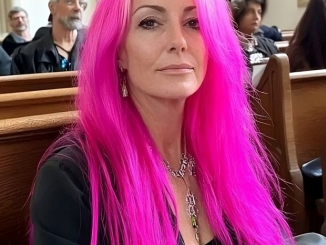A groundbreaking moment in cancer research has unfolded as Professor Richard Scolyer, a renowned pathologist from the University of Sydney, celebrates being declared cancer-free after battling stage 4 glioblastoma—a diagnosis often deemed a death sentence. What makes his story extraordinary is that the treatment responsible for his recovery was partly developed by him, offering a beacon of hope for countless patients facing similar challenges.
From Diagnosis to Determination

It all began in May 2023 when Professor Scolyer was traveling across Europe to attend medical conferences. During a stop in Poland, he suffered a seizure that led to the shocking discovery of an aggressive brain tumor—stage 4 glioblastoma.
Glioblastoma is widely considered one of the most aggressive and incurable forms of brain cancer, with an average survival rate of just 12 to 18 months. The diagnosis was grim, but Scolyer, a leading pathologist and co-medical director of the Melanoma Institute Australia, was not ready to give up.
Instead of succumbing to the bleak prognosis, he resolved to leverage his expertise and resources to fight back. With unwavering determination, he turned to the very field he had spent his career advancing: immunotherapy.
Revolutionizing Cancer Treatment
Central to Professor Scolyer’s remarkable recovery is a revolutionary treatment protocol developed in collaboration with his esteemed colleague, Dr. Georgina Long. Together, they designed a groundbreaking immunotherapy-based regimen tailored to combat Scolyer’s aggressive tumor.
Harnessing the Power of Immunotherapy
Immunotherapy, which uses the body’s immune system to target and destroy cancer cells, has already transformed cancer care in certain areas, particularly melanoma. But applying it to glioblastoma presented a new challenge.
The innovative treatment involved pre- and post-surgery immunotherapy drugs, designed to stimulate the immune system to recognize and attack cancer cells more effectively. This approach marked a significant departure from traditional methods and represented a new frontier in glioblastoma care.
Tailored Vaccines and Radiotherapy
A key component of Scolyer’s treatment was a personalized vaccine developed specifically to target his tumor’s unique characteristics. This precision medicine approach highlights how individualized therapies are revolutionizing cancer care.
In addition to the vaccine, Scolyer underwent rigorous rounds of radiotherapy following the surgical removal of the tumor. The combination of cutting-edge immunotherapy, precision vaccines, and traditional treatments created a powerful, multi-pronged strategy that ultimately led to his remarkable recovery.
Overcoming Trials and Tribulations

While the treatment itself was groundbreaking, Scolyer’s journey was far from easy. His recovery process was riddled with complications, including debilitating epileptic seizures, liver dysfunction, and even pneumonia. Each challenge tested his resolve, but he refused to back down.
Through sheer perseverance and the support of his medical team, Scolyer gradually reclaimed pieces of normalcy. He shared his journey candidly on social media, inspiring countless others with his resilience and determination.
A Landmark Achievement
In a moment that can only be described as extraordinary, Scolyer’s latest MRI scan revealed no signs of tumor recurrence. While he acknowledges that the fight against glioblastoma is ongoing, being declared tumor-free is an achievement few could have anticipated given his initial diagnosis.
His story is not only a personal triumph but also a landmark in medical science. It demonstrates the potential of personalized, cutting-edge therapies to rewrite the prognosis for conditions once considered incurable.
What This Means for Glioblastoma Patients
Glioblastoma has long been one of the most challenging cancers to treat. The tumor’s rapid growth, resistance to traditional treatments, and its tendency to infiltrate surrounding brain tissue have made progress in this area slow. However, Scolyer’s success shines a light on the potential of immunotherapy and personalized medicine to change the landscape for patients with glioblastoma.

Key Takeaways for the Future
- Collaboration Is Key: Scolyer’s case highlights the importance of collaboration between researchers, clinicians, and patients in driving innovation.
- Immunotherapy’s Potential: The success of this treatment regimen underscores the growing promise of immunotherapy as a game-changing approach to cancer care.
- Precision Medicine: Tailoring treatments to the unique characteristics of each patient’s cancer is proving to be a powerful tool in improving outcomes.
A Message of Hope
While glioblastoma remains a formidable adversary, Professor Scolyer’s journey offers a message of hope. It serves as a reminder that even in the face of the most challenging circumstances, progress is possible. His story inspires not only patients but also the scientific community to continue pushing the boundaries of what’s possible in cancer care.
The Road Ahead
As Professor Scolyer celebrates his recovery, he remains acutely aware of the road ahead. His battle with glioblastoma is far from over, and ongoing monitoring will be essential. Nevertheless, his story is a testament to the resilience of the human spirit and the transformative power of science and innovation.

For millions of patients and families affected by cancer, stories like Scolyer’s represent a beacon of hope. They remind us that every step forward in medical research brings us closer to a future where even the most aggressive cancers can be overcome.
Conclusion: A Triumph of Science and Spirit
Professor Richard Scolyer’s journey from a devastating diagnosis to being declared cancer-free is nothing short of extraordinary. By combining cutting-edge immunotherapy, precision medicine, and unyielding determination, he has achieved a victory that few thought possible.
His story is a powerful reminder of the potential of medical innovation and the importance of never giving up. As we celebrate his triumph, let’s also honor the countless researchers, clinicians, and patients who continue to fight for a brighter future in cancer care.


